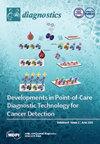通过IVIM-DWI参数和信号衰减分析表征乳腺肿瘤异质性。
摘要
背景/目的:本研究提出了一种利用体素内非相干运动扩散加权成像(IVIM-DWI)结合高光谱成像技术和深度学习的乳腺肿瘤特征和组织分类的新分析方法。传统上,动态对比增强MRI (DCE-MRI)用于乳腺肿瘤的诊断,但它涉及到基于钆的对比剂,具有潜在的健康风险。IVIM成像通过明确地将信号衰减分为代表真分子扩散(D)和毛细血管微循环(伪扩散或D*)的分量,扩展了传统的弥散加权成像(DWI)。这种分离可以在不需要造影剂的情况下对组织特征进行更全面、无创的评估,从而为乳腺癌诊断提供了一种更安全的选择。本研究的主要目的是评估将IVIM-DWI数据作为高光谱图像堆栈处理的乳腺肿瘤表征的不同方法。采用骰子相似系数和Jaccard指数评估肿瘤边界的空间分割准确性,由经验丰富的医生在动态对比增强MRI (DCE-MRI)上证实,强调肿瘤的详细特征,而不是癌症的二元诊断。方法:本研究的数据来源为22例肿块型乳腺癌患者的乳腺MRI扫描,分析22例不同的肿块性肿瘤病例。使用3T MRI系统(Discovery MR750 3.0 Tesla, GE Healthcare, Chicago, IL, USA),轴向IVIM序列和双极脉冲梯度自旋回波序列获得MR图像。使用了从0到2500 s/mm2的多个b值,特别是13个原始b值(0、15、30、45、60、100、200、400、600、1000、1500、2000和2500 s/mm2),最后四个b值图像复制一次,用于分析的总共17个波段。该方法包括以下几个步骤:获取多b值IVIM-DWI图像,图像预处理,包括校正运动和强度不均匀性,将多b值数据处理为高光谱图像堆栈,应用波段扩展等高光谱技术,并评估三种肿瘤检测方法:基于核的约束能量最小化(KCEM),迭代KCEM (I-KCEM)和深度神经网络(dnn)。通过评估每种方法的检测结果与真实肿瘤区域的相似性来评估比较,这些区域是人工绘制在DCE-MRI图像上并由经验丰富的医生确认的。使用Dice相似系数和Jaccard指数定量测量相似性。此外,使用3D-ROC分析及其衍生标准(AUCOD, AUCTD, AUCBS, AUCTD- bs, AUCODP, AUCSNPR)评估检测器的性能。结果:研究结果客观地证明了DNN方法在乳腺肿瘤检测方面优于KCEM和I-KCEM。其中,DNN的Dice相似系数为86.56%,Jaccard相似系数为76.30%,而KCEM的Dice相似系数为78.49%,Jaccard相似系数为64.60%,I-KCEM的Dice相似系数为78.55%,Jaccard相似系数为61.37%。使用3D-ROC分析的评估也表明,基于目标检出率和总体有效性等指标,DNN是最佳检测器。DNN模型进一步显示出识别肿瘤异质性、区分高细胞区和低细胞区的能力。计算并分析表观扩散系数(ADC)、纯扩散系数(D)、伪扩散系数(D*)、灌注分数(PF)等定量参数,深入了解乳腺不同组织的扩散特征。由这些参数产生的信号强度衰减曲线分析进一步说明了不同的扩散模式,并证实高细胞肿瘤区域比低细胞肿瘤区域表现出更大的水分子限制。结论:本研究强调了将IVIM-DWI、高光谱成像技术和深度学习结合起来作为一种强大、安全、有效的非侵入性乳腺癌诊断工具的潜力,通过提供有关组织微观结构和异质性的详细信息而无需造影剂,为对比增强方法提供了有价值的替代方法。Background/Objectives: This research presents a novel analytical method for breast tumor characterization and tissue classification by leveraging intravoxel incoherent motion diffusion-weighted imaging (IVIM-DWI) combined with hyperspectral imaging techniques and deep learning. Traditionally, dynamic contrast-enhanced MRI (DCE-MRI) is employed for breast tumor diagnosis, but it involves gadolinium-based contrast agents, which carry potential health risks. IVIM imaging extends conventional diffusion-weighted imaging (DWI) by explicitly separating the signal decay into components representing true molecular diffusion (D) and microcirculation of capillary blood (pseudo-diffusion or D*). This separation allows for a more comprehensive, non-invasive assessment of tissue characteristics without the need for contrast agents, thereby offering a safer alternative for breast cancer diagnosis. The primary purpose of this study was to evaluate different methods for breast tumor characterization using IVIM-DWI data treated as hyperspectral image stacks. Dice similarity coefficients and Jaccard indices were specifically used to evaluate the spatial segmentation accuracy of tumor boundaries, confirmed by experienced physicians on dynamic contrast-enhanced MRI (DCE-MRI), emphasizing detailed tumor characterization rather than binary diagnosis of cancer. Methods: The data source for this study consisted of breast MRI scans obtained from 22 patients diagnosed with mass-type breast cancer, resulting in 22 distinct mass tumor cases analyzed. MR images were acquired using a 3T MRI system (Discovery MR750 3.0 Tesla, GE Healthcare, Chicago, IL, USA) with axial IVIM sequences and a bipolar pulsed gradient spin echo sequence. Multiple b-values ranging from 0 to 2500 s/mm2 were utilized, specifically thirteen original b-values (0, 15, 30, 45, 60, 100, 200, 400, 600, 1000, 1500, 2000, and 2500 s/mm2), with the last four b-value images replicated once for a total of 17 bands used in the analysis. The methodology involved several steps: acquisition of multi-b-value IVIM-DWI images, image pre-processing, including correction for motion and intensity inhomogeneity, treating the multi-b-value data as hyperspectral image stacks, applying hyperspectral techniques like band expansion, and evaluating three tumor detection methods: kernel-based constrained energy minimization (KCEM), iterative KCEM (I-KCEM), and deep neural networks (DNNs). The comparisons were assessed by evaluating the similarity of the detection results from each method to ground truth tumor areas, which were manually drawn on DCE-MRI images and confirmed by experienced physicians. Similarity was quantitatively measured using the Dice similarity coefficient and the Jaccard index. Additionally, the performance of the detectors was evaluated using 3D-ROC analysis and its derived criteria (AUCOD, AUCTD, AUCBS, AUCTD-BS, AUCODP, AUCSNPR). Results: The findings objectively demonstrated that the DNN method achieved superior performance in breast tumor detection compared to KCEM and I-KCEM. Specifically, the DNN yielded a Dice similarity coefficient of 86.56% and a Jaccard index of 76.30%, whereas KCEM achieved 78.49% (Dice) and 64.60% (Jaccard), and I-KCEM achieved 78.55% (Dice) and 61.37% (Jaccard). Evaluation using 3D-ROC analysis also indicated that the DNN was the best detector based on metrics like target detection rate and overall effectiveness. The DNN model further exhibited the capability to identify tumor heterogeneity, differentiating high- and low-cellularity regions. Quantitative parameters, including apparent diffusion coefficient (ADC), pure diffusion coefficient (D), pseudo-diffusion coefficient (D*), and perfusion fraction (PF), were calculated and analyzed, providing insights into the diffusion characteristics of different breast tissues. Analysis of signal intensity decay curves generated from these parameters further illustrated distinct diffusion patterns and confirmed that high cellularity tumor regions showed greater water molecule confinement compared to low cellularity regions. Conclusions: This study highlights the potential of combining IVIM-DWI, hyperspectral imaging techniques, and deep learning as a robust, safe, and effective non-invasive diagnostic tool for breast cancer, offering a valuable alternative to contrast-enhanced methods by providing detailed information about tissue microstructure and heterogeneity without the need for contrast agents.

 求助内容:
求助内容: 应助结果提醒方式:
应助结果提醒方式:


